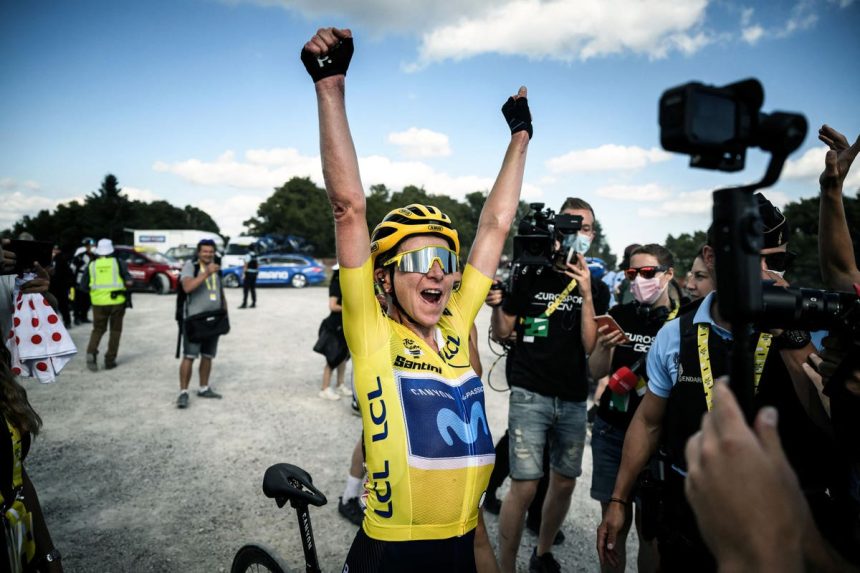This summer is shaping up to be a spectacular season for sports fans. The Tour de France and Wimbledon are already underway, and later this month, you’ll have a chance to cheer on the U.S. women’s national soccer team (USWNT) as they vie for their fifth Women’s World Cup championship, witness the jaw-dropping feats, perseverance, and heart-pounding drama of the second Tour de France Femmes avec Zwift, and watch women skateboarders shred in the thrilling vert competition at the X Games for the first time in 13 years.
With three of the biggest events in their respective sports all taking place at the end of July, it seems an appropriate time to reflect on what this moment means and the potential future of women’s sports. In soccer, cycling, and skateboarding, women have had to fight tirelessly just to get a small fraction of the opportunity afforded to men in their respective sports—including even just the chance to compete. The justification for the lack of equal opportunity in sports typically falls back on economics. Sports are a business, after all. And while that is of course true, the facts don’t support the claim that women’s sports aren’t good business. Just the opposite in fact.
Women’s sports are incredibly entertaining and have proven themselves capable of drawing high viewership. When our women’s soccer team plays, people watch. The USWNT knows how to bring in views, and its World Cup games are some of the most watched sporting events in U.S. television history, consistently outpacing expectations (and the U.S. men’s team), often racking up more views than other popular sports competitions—like the NBA Finals and Stanley Cup—and shattering records. What the numbers make clear is that people care about and want to watch women’s soccer.
And this isn’t a one-off phenomenon. Last year, the inaugural Tour de France Femmes avec Zwift—the first proper Women’s Tour de France—reached 23.2 million viewers and commanded an audience share higher than that of the men’s Giro d’Italia, according to Zwift’s Women’s Cycling Report, an in-depth analysis of data from Nielsen Sports that was published today. In its first year, the event proved a resounding success, generating enthusiastic fanfare, bringing in millions of viewers, and leaving many with the sense that the future of women’s cycling is brimming with opportunity. On the topic, Zwift director of women’s strategy Kate Veronneau said, ”It would be an understatement to say that we were thrilled by the response to the inaugural Tour de France Femmes avec Zwift. The data speaks for itself: over 100 million hours viewed across 190 countries.”
Indeed, last year’s success has helped the race garner brand buy-in. Cassondra Spring, global brand manager of Liv Cycling, the tour’s bike sponsor and white jersey sponsor, said, “Seeing the viewership numbers of last year’s race helps us to know that the world does want to watch women’s cycling events and cheer on these exceptional athletes.” Yet, the future of the Tour de France Femmes is uncertain beyond the next three years, and without adequate sponsorship and widespread broadcasting, these professional cyclists’ uphill climb gets uncomfortably close to vertical.
For any business to succeed, it has to be profitable. It’s simple economics. And women’s sports are profitable. The U.S. women’s national soccer team is the perfect case study: as verified by fact-checking website Politifact, even as the USWNT was paid less and given less support than the U.S. men’s team, it was generating greater revenue for the U.S. Soccer Federation than the men. The numbers demonstrate that when women’s sports are invested in, not only are they profitable, but they are capable of generating as much and even more revenue than men’s sports. Speaking to the Wall Street Journal, Becca Roux, executive director of the U.S. women’s national team’s players association, said, “The event revenue from the USWNT demonstrates the potential that can be realized when investment is made.”
Investment is the critical word here. This means sufficient funding, comprehensive marketing support and merchandising, and proper media and broadcast coverage. Cheryl Cooky, a professor of interdisciplinary studies at Purdue University who has tracked and analyzed over 30 years of data on the quantity and quality of sports broadcast coverage, has found that women’s sports are still “dismally” underrepresented in the media. According to her research, women’s sports accounted for only 5.4% of all televised sports airtime, a figure that’s been nearly unchanged for three decades. Excluding coverage of the 2019 Women’s World Cup, women’s share drops to a paltry 3.5%. “Women’s coverage is absent, largely, of the elements that we know make watching sport highlights compelling and interesting: exciting commentary, colorful, descriptive, animated delivery, and thoughtful, high-production value interviews and game footage. When you compare women’s coverage to men’s, the women’s comes across as quite bland,” Cooky said in a press release.
When women’s sports struggle and fail, there is often this performative head scratching that follows, with folks asking what it is about women’s sports that makes them less exciting, less profitable than men’s, as if some inherent shortcoming of women is to blame. But the answer is business, plain and simple. If you don’t put in enough funding, if you don’t invest in marketing, and—when it comes to the business of sports—if you aren’t getting quality broadcast minutes and media coverage, your business is going to fail.
Just look at the struggles women’s skateboarding has had to overcome. A little over a decade ago, while men pro skaters were getting industry and mainstream coverage and could earn a living through their sponsorships and lucrative endorsements, the best women in the sport had no opportunities to compete (their only path to sponsorship at the time), received virtually no media and broadcasting coverage, and professional women’s skateboarders weren’t even being paid. And in 2011, women skaters were dealt a devastating blow when the X Games eliminated Women’s Vert, the only remaining major vert competition for women at the time.
That’s in stark contrast to the progress women’s skateboarding has made since, thanks in large part to the skaters’ own efforts to shine a light on the issue and carve out their own space in the industry as well as the influential followings pro women skateboarders have amassed on their own through social media. After years of fighting tooth and nail and even building their own businesses and competitions, pro women skaters are at a watershed moment. In just a few short weeks, for the first time in 13 years, women vert skaters will finally be able to compete on the sport’s biggest stage: the X Games. Vert is often viewed as the most exciting and fun to watch skateboarding event, and it’s the kind of skating that made Tony Hawk a household name (something that may never have happened without the stage of ESPN’s X Games and the competition’s global broadcasting that brought skateboarding to our living rooms).
Women athletes have proven time and time again what they’re capable of both on and off the field. It’s well past time the media and major brands start paying attention. Simply put, women’s sports are good business. With proper investment, media buy-in, and quality broadcast, they have the ability to be incredibly profitable.
Read the full article here










